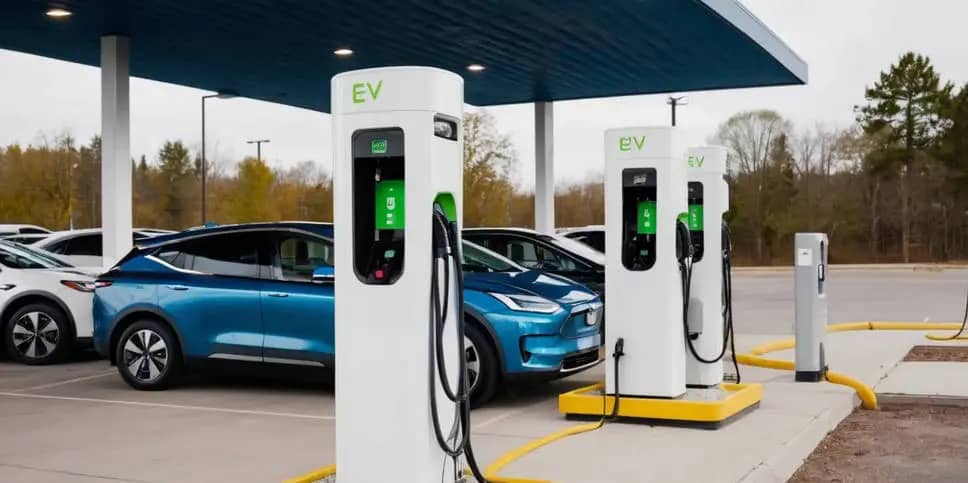Electric vehicles (EVs) like battery electric vehicles (BEVs), plug-in hybrid electric vehicles (PHEVs), and fuel cell electric vehicles (FCEVs) are gaining momentum in the United States auto market.
With over 2 million EVs now traveling U.S. roads and electric versions of popular models like the Ford F-150 Lightning and Chevy Silverado EV launching soon, consumer adoption is accelerating. But one persistent challenge faced by EV drivers is often finding gas-powered “internal combustion engine” (ICE) vehicles parked in designated electric vehicle charging stations, a practice known as “ICEing.”
ICEing can prevent EV drivers from charging their vehicles, especially in areas with limited public charging infrastructure.
In response, a growing number of states and cities across America have passed laws prohibiting non-EVs from parking in signed EV charging stations. While supporters argue these laws are necessary to ensure accessibility to charging, critics question if strict bans are the best approach. This article will examine the rationale, effectiveness, and potential impacts of the rising trend of anti-ICEing legislation taking hold in the U.S.
The main intent of laws prohibiting ICE vehicles from using EV charging spots is simple – to keep the spaces open so EV drivers can charge their vehicles without getting blocked by gas cars. For drivers of all-electric BEVs, access to charging is especially essential. Getting ICEd can cause major inconvenience and disruption if BEV owners are left stranded with low state of charge and unable to reach their destination or return home. Even PHEV drivers rely on using charging stations regularly to maximize electric miles driven.

Advocates of anti-ICEing bills also argue that the laws are necessary because signage alone hasn’t stopped the problem. Voluntary compliance is inconsistent, especially in high-demand public parking locations. Clear legal prohibitions combined with penalties provide a stronger mechanism for keeping ICE vehicles from occupying dedicated charging infrastructure. This helps municipalities justify costs of installing public EV charging stations and commercial hosts deploy workplace and retail EV chargers.
There is also an equity argument, as lower income drivers with older gas cars may be more likely to ICE out EV drivers who have invested in newer electric vehicle technology. Bans aim to protect charging access for those adopting electric transportation. Finally, some see additional benefits like encouraging EV adoption and reducing emissions if gas car owners are dissuaded from blocking stations.
Anti-ICEing legislation has faced criticism from those who feel that strict bans are unnecessary or unfair. One counterargument is that ICEing is not always intentional – some gas car drivers simply don’t notice the EV charging signs. They argue that public education campaigns would be more appropriate than fines or towing.
Others see anti-ICEing laws as overreach into public parking spaces that don’t belong exclusively to EVs. They point out ambiguities, like a plugged-in EV occupying a charger but not actively charging. And while blocking stations is rude, laws reserving public parking spaces for a single class of vehicle may rub some the wrong way.
There are also concerns that fines disproportionately affect lower income ICE vehicle owners violating the laws. Towing gas cars from EV stations could leave drivers stranded far from home. And some critics argue that if charging infrastructure remains limited, having priority over public parking is an unfair perk for those who can afford expensive EVs.
Surveys of public opinion on anti-ICEing legislation have shown divided views. Support appears higher among EV drivers who have personally experienced ICEing incidents. Younger demographics also tend to favor laws reserving charging station access for EVs only. But results suggest more mixed feelings or opposition among much of the general public.
At least 12 states across the U.S. and a growing number of cities have now passed laws prohibiting ICE vehicles from parking in signed EV charging spots. Penalties vary widely, ranging from $50 to $350. Most of these laws have been enacted within the past few years as EVs gain momentum in the auto market.
California was the first state to implement anti-ICEing legislation in 2013. The minimum fine for blocking an EV charging spot is $100, with maximums over $400 for repeat violations. Other West Coast states like Washington and Hawaii have followed California’s lead. Some East Coast states like Maryland, Rhode Island, and New York have joined more recently.
Major cities across the U.S. with anti-ICEing ordinances include New York City, Seattle, Baltimore, Los Angeles, and San Francisco. Fines in city codes tend to be on the lower side – commonly $50 to $100. Some cities like Denver also authorize towing of ICE vehicles violating EV charging station bans.
Research examining the impact of anti-ICEing laws is still limited. However, initial analysis by UCLA researchers studying data in California suggests that prohibiting ICE vehicles from using EV charging spots significantly improves station availability. Further evaluation over longer periods across more states and cities would provide useful insights on the effectiveness of emerging anti-ICEing legislation.
Laws reserving EV charging stations for only electric vehicles offer some clear benefits – they provide a strong mechanism to keep chargers accessible and simplify enforcement. But there are also valid concerns about fairness, penalty severity, and unintended consequences.
Well-designed public education campaigns should supplement anti-ICEing bills to raise awareness. Towing seems excessive in many cases – fines scaled based on frequency are more reasonable. And while bans address a real problem, they should be combined with efforts to expand public charging access long-term to match rising EV adoption.
Anti-ICEing legislation appears likely to spread as more electric vehicles hit the roads in the U.S. auto market. Policymakers must strike the right balance between protecting charging access and being even-handed toward all drivers. With prudent planning and fair enforcement, laws prohibiting gas vehicles from EV charging spots can play a constructive role in the transition to electric transportation.